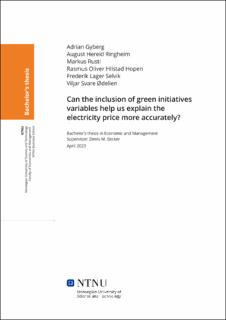| dc.contributor.advisor | M. Becker, Denis | |
| dc.contributor.author | Gyberg, Adrian | |
| dc.contributor.author | Hereid Ringheim, August | |
| dc.contributor.author | Lager Selvik, Frederik | |
| dc.contributor.author | Oliver Hilstad Hopen, Rasmus | |
| dc.contributor.author | Rusti, Markus | |
| dc.contributor.author | Svare Ødelien, Viljar | |
| dc.date.accessioned | 2023-06-14T17:20:12Z | |
| dc.date.available | 2023-06-14T17:20:12Z | |
| dc.date.issued | 2023 | |
| dc.identifier | no.ntnu:inspera:140915232:145930685 | |
| dc.identifier.uri | https://hdl.handle.net/11250/3071432 | |
| dc.description.abstract | Med økt bruk av fornybare energikilder og grønne initiativer vil det de kommende årene være
en stor ending i strømmarkedet. Denne bacheloroppgaven undersøker rollen grønne initiativer
kan ha å forklare endinger i elektrisitetspriser mer nøyaktig ved å benytte «Ordinary Least
Squares» (OLS) regresjonsmodeller. Vi vil utarbeide to modeller som så skal sammenlignes i
denne oppgaven: en som bruker flere variabler som man vet påvirker strømprisen videre en
modell hvor variabler for grønne initiativer inkluderes.
Variablene som blir introdusert som grønne initiativer er både fra tilbuds og
etterspørselssiden i energibalansen. På tilbudssiden inkluderer vi variabler fra produksjon av
strøm fra vindmøller og på etterspørselssiden inkluderer vi elektrifisering av den norske
bilparken og elektrifisering av den norske kontinentalsokkelen som står for produksjon av
olje og gas. Til slutt inkluderer vi også prisen på EUs ETS CO2-kvoter, som fungerer som et
grønt initiativ. Analysen utføres ved hjelp av historiske data som strekker seg fra 2011 til
2022. Hvor det spesifikke området er vi tar for oss er NO1, eller sørøstlige delen av Norge
som i oppgaven er betegnet som «OSLO».
Det vi har funnet har gitt oss en bedre forståelse av de ulike faktorene som påvirker
strømprisen, noe som er avgjørende for å lage nøyaktige modeller både for prediksjon og
forklaring. Det kan være problematisk å konkludere med at det å inkludere grønne initiativer
vil føre til en bedre OLS-modell. Grunnen for dette er at valgene vi har valgt rundt variabler
samt interpolering av dataene kan ha svekket påliteligheten til resultatet videre er det sentralt
å trekke inn at overtilpassing av modellen til dataen også kan være et problem. | |
| dc.description.abstract | The rapid expansion of renewable energy sources and green initiatives has transformed the
power market landscape. This bachelor thesis examines the role of green initiatives in
explaining electricity price fluctuations more accurately by employing Ordinary Least
Squares (OLS) regression models. Two models are compared in this thesis: one incorporating
green initiatives variables, and another excluding them.
The green initiatives variables consist of initiatives from both the production and the
consumption side of the energy balance. On the production side we are including variables
from production of green electricity from windmills and on the consumption side we are
including electrification of the Norwegian car fleet and the electrification of the Norwegian
continental shelf. Lastly, we are also including the price of EU`s ETS CO2 allowances which
is an initiative. These factors are integrated into the first model, while the second model
solely relies on traditional factors. The analysis is conducted using historical data reaching
from 2011 to 2022 and the specific area is NO1 or the south-east part of Norway.
Insights gained from our findings have facilitated a more profound comprehension of the
factors influencing electricity prices, which is crucial for making accurate models for both
explaining and predicting. It can be problematic to conclude that the inclusion of green
initiatives will lead to a better OLS model. Because the manual selection of variables and
interpolating of the data, in retrospect, could have potentially compromised the reliability of
our findings. Furthermore, it is also important to mention that over-fitting of the model to the
data can lead to problems when we are looking closer into other dataset with a different mix. | |
| dc.language | eng | |
| dc.publisher | NTNU | |
| dc.title | Can the inclusion of green initiatives variables help us explain the electricity price more accurately? | |
| dc.type | Bachelor thesis | |
